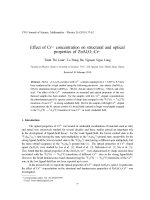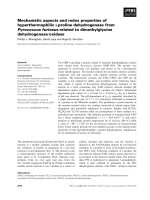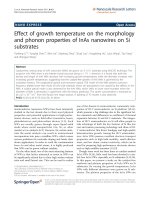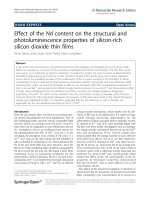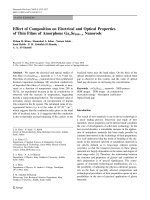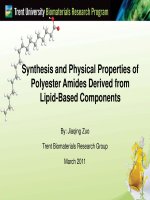CMR effect and related properties of mo based oxides with double perovskite structure
Bạn đang xem bản rút gọn của tài liệu. Xem và tải ngay bản đầy đủ của tài liệu tại đây (2.5 MB, 140 trang )
I
CMR EFFECT AND RELATED PROPERTIES OF
Mo-BASED OXIDES WITH DOUBLE-PEROVSKITE
STRUCTURE
YUAN CAILEI
( M. Sc, ISSP )
A THESIS SUBMITTED
FOR THE DEGREE OF DOCTOR OF PHILOSOPHY
DEPARTMENT OF PHYSICS
NATIONAL UNIVERSITY OF SINGAPORE
2003
II
DEDICATIONS:
To mentors for their guidance
To family for their love
Acknowledgement
III
Acknowledgements
A journey is easier when you travel together. Interdependence is certainly more
valuable than independence. This thesis is the result of three years of work whereby I
have been accompanied and supported by many people. It is a pleasant journey that I
have now the opportunity to express my gratitude to all of them.
First of all, I would like to extend my wholehearted thanks to my supervisor Prof.
Ong Phee Poh. He is a great supervisor as well as a respected mentor. He creates
ladders of hope and mobility that a toddler like me can ascend, rising as far as abilities
permit. He taught me to overcome fresh obstacles, be definite in aims, unshaken by
failure, utterly honest with people, and almost every aspect of life and research that
educated me not only to be a knowledgeable scholar but to be an intellectual of great
personality as well. I will always remember the happy time we worked and enjoyed
together.
I am also deeply indebted to my mentor Dr. Zhu Yong who’s consistent and patient
assistance, stimulating suggestions and encouragement helped me throughout the time
of my study and research in NUS.
Many, many people have helped me out when I came across difficulties during the
development of this thesis. I would like to give special thanks to Prof. Ong Chong Kim,
Dr. Li Jie and Dr. Huang Qiang at the Center for Superconducting and Magnetic
Materials (CSMM) for their assistance in magnetic transport measurements.
My sincere thanks are due to Associate Professor Shen Zexiang and Dr. Yu Ting of the
Acknowledgement
IV
Physics Department for their help in Raman spectra measurements. I also especially
thank my friends Prof. Zeng Zhaoyang of Physics Department, Jiangxi Normal
University and Mr. Yu Ting of Microelectronics Division, Nanyang Technological
University for their useful discussions and helps in magnetic transport measurements. I
thank all my colleagues at the department for their friendship and daily assistance.
This research has been supported and funded by National University of Singapore.
Thanks for providing all the facilities and financial support that enable me to complete
this thesis.
I also want to thank my parents, who taught me the value of hard work by their own
example. I would like to share this moment of happiness with them. They rendered me
enormous support during the whole tenure of my research. Without them, I will be
nothing.
Lastly, I am grateful to my wife for the inspiration and moral support she provided
throughout my research work and her patience was tested to the utmost by a long period
of separation. Without her loving support and understanding I would never have
completed my present work.
Finally, I would like to thank all whose direct and indirect support helped me
complete my thesis in time.
Publications based on the Ph.D research
V
PUBLICATIONS BASED ON THE PH.D RESEARCH
1. Temperature Dependence of Resistivity of
δ
−62
CoMoOSr Films
C. L. Yuan, Z. Y. Zeng, Y. Zhu, P. P. Ong, Z. X. Shen, C. K. Ong
Phys. Rev. B (Submitted)
2. Influence of preparation method on SrMoO
4
impurity content and
magnetotransport properties of double perovskite Sr
2
FeMoO
6
polycrystals
C. L. Yuan, Y. Zhu, P. P. Ong, Z. X. Shen, C. K. Ong
Solid. State. Commu. 129, 551 (2004)
3. Grain boundary effects on the magneto-transport properties of Sr
2
FeMoO
6
induced
by variation of the ambient H
2
-Ar mixture ratio during annealing
C. L. Yuan, Y. Zhu, P. P. Ong, C. K. Ong, T. Yu, Z. X. Shen
Physica B: Condensed Matter 334, 408 (2003)
4. Enhancement of room-temperature magnetoresistance in Sr
2
FeMoO
6
by reducing
its grain size and adjusting its tunnel-barrier thickness
C. L. Yuan, Y. Zhu, P. P. Ong
Appl. Phys. Lett. 82, 934 (2003)
5. Effect of Cu doping on the magnetoresistive behavior of double perovskite
Sr
2
FeMoO
6
polycrystals
C. L. Yuan, Y. Zhu, P. P. Ong
J. Appl. Phys. 91, 4421 (2002)
6. The effects of Cu doping on the magnetoresistive behavior of perovskites
La
0.7
Ca
0.3
MnO
y
C. L. Yuan, Y. Zhu, P. P. Ong
Solid. State. Commu. 120, 495 (2001)
7. Enhancement of photoluminescence in Ge nanoparticles by neighboring
amorphous C in composite Ge/C thin films
Y. Zhu, C. L. Yuan, P. P. Ong
J. Appl. Phys. 93, 6029 (2003)
8. Suppression of uv photoluminescence in sandwich-structured Si/C composite films
Y. Zhu, C. L. Yuan, R. Liu, P. P. Ong
Europhys. Lett. 60, 323 (2002)
Publications based on the Ph.D research
VI
9. Room-temperature visible photoluminescence from undoped ZnS
nanoparticles embedded in SiO
2
matrices
Y. Zhu, C. L. Yuan, P. P. Ong
J. Appl. Phys. 92, 6828 (2002)
10. Co-existing photoluminescence of Si and Ge nanocrystals in Ge/Si thin
film without cross-interference
Y. Zhu, C. L. Yuan, S. L. Quek, S. S. Chan, P. P. Ong, Q. T. Li
J. Appl. Phys. 90, 5318 (2001)
11. Formation of double-perovskite Sr
2
FeMoO
6
nanoparticles by mechanical
activation
T. Yu, Z. X. Shen, W. S. Toh, C. L. Yuan, P. P. Ong, J. Wang
ICMAT 2003
List of figures
VII
LIST OF FIGURES
Chapter 1
Fig.1.1. Ordinary magnetoresistance (OMR)
(J. M. D. Coey, J. Appl. Phys. 85, 5576 (1999))
……………………………………………… ………………………… ……………3
Fig.1.2. Anisotropic magnetoresistance (AMR)
(J. M. D. Coey, J. Appl. Phys. 85, 5576 (1999))
……………………………………………… ….…………… …………………… 4
Fig.1.3. Giant magnetoresistance (GMR)
(J. M. D. Coey, J. Appl. Phys. 85, 5576 (1999))
……………………………………………… ……………………… …………….5
Fig.1.4. Colossal magnetoresistance (CMR)
(J. M. D. Coey, J. Appl. Phys. 85, 5576 (1999))
……………………………………………… ……………………… …………… 6
Fig.1.5. Crystal structures of the most important oxides discussed in this review:
(a) pyrochlore structure (Tl
2
Mn
2
O
7
) showing the tetrahedral manganese array.
The Mn
4+
ions are octahedrally coordinated by oxygen, and they form a
corner-sharing tetrahedral array.
(M. Venkatesan et al. J.Phys.: Condens Matter 16, 3465 (2004))
(b) n=2 Ruddlesden-Popper phase (La
1.2
Sr
1.8
Mn
2
O
7
)
(Y. Moritomo et al. Nature 380, 141 (1996))
(c) perovskite structure (La
0.7
Sr
0.3
MnO
3
)
(J. M. D. Coey, J. Appl. Phys. 85, 5576 (1999))
……………………………………………………………… …………………… 7
Fig.1.6. Schematic diagram of the double-exchange mechanism. The two states
++ 4 3
Mn-Mn
and
++ 34
Mn-Mn are degenerate if the manganese spins are parallel.
(C. Zener, Phys. Rev. 81, 440 (1951))
……………………………………………….……………………………… …… 8
Fig.1.7. Typical resistivity versus temperature curves of La
0.7
(Ca
1-y
Sr
y
)
0.3
MnO
3
single
crystals. The anomaly at a temperature of 370 K for the y = 0.45 doping is due to a
structural transition from a low-temperature orthorhombic to a high-temperature
rhombohedra phase.
(Y. Tomioka et al. Phys. Rev. B 63, 024421 (2001))
…………………………………………………… ……….…….…………….…….10
List of figures
VIII
Fig.1.8. Crystal structure and the density of states (DOS) of Sr
2
FeMoO
6
.
K-I. Kobayashi et al. Nature 395 677 (1998)
…………………………………………………… ……….……………….….…….15
Fig.1.9. (a) Temperature dependence of the resistivity for different grain-size
Sr
2
FeMoO
6
: samples A (29 nm), B (35 nm), C (45 nm) at zero field (solid line) and 4
kG (dash line). (b) Temperature dependence of the magnetoresistance ratio
(0)(H)]/-(0)[ MR
ρ
ρ
ρ
= for Sr
2
FeMoO
6
at 4 kG.
(Yuan
et al. Appl. Phys. Lett.75, 3853 (1999)
…………………………………………………… ……….……….………….…….21
Fig.1.10. The normalized low-field magnetoresistance of Sr
2
FeMoO
6
, defined
as (0)kOe)]/ (2-(0)[ MR
*
ρρρ
= , plotted as a function of the reduced temperature T/T
C
with those of Tl
2
Mn
2
O
3
, CrO
2
and La
0.67
Sr
0.33
MnO
3
(Kim
et al. Appl. Phys. Lett. 74, 1737 (1999))
…………………………………………………… …….…………………….….….22
Chapter 2
Fig.2.1. The Sr
2
FeMoO
6
sample synthesis procedure by the sol-gel method.
……………………………………………………………………………….…….….34
Fig.2.2. The Sr
2
CoMoO
6
sample synthesis procedure by the sol-gel method.
……………………………………………………………………………… …….…35
Fig.2.3. The La
0.7
Ca
0.3
Mn
1-x
Cu
x
O
y
samples synthesis procedure by the solid-state
reaction.
……….……………………………………………………………………….……….36
Fig.2.4.
Illustration of Pulsed Laser Deposition (PLD) system.
………………………………………………………………………………….…… 38
Fig.2.5. (a) Conditions for Bragg scattering (b) Detector arrangement.
……………………………………………………………………… ………….……41
Fig.2.6. The Jobin Yvon-Spex T64000 Triple Grating system.
…………………………………………………………… ………………… …… 42
Fig.2.7. Schematic diagram of a scanning electron microscopy.
……………………………………………………………………………………… 45
List of figures
IX
Fig.2.8. Schematic illustration of the experimental set-up for the 4-point probe
measurement.
……………………………….……………………………………………….……….47
Fig.2.9. System diagram of Vibrating sample magnetometer (VSM).
……………………………………………………………………….……….……….49
Chapter 3
Fig.3.1. X-ray diffraction patterns of polycrystalline Sr
2
FeMoO
6
samples A, B, C and
D with different preparation conditions. The magnified section in the range
oo
30225 <<
θ
containing the strongest peaks of the SrMoO
4
impurity phase of
samples A and B are shown in the inset.
…………………………………………………………… ………… …………… 56
Fig.3.2. Raman spectra of samples A, B, C and D at room temperature, the peak
labeled “*” is attributed to SrMoO
4
.
………………………………………………………………………… ……………57
Fig.3.3. SEM micrographs showing the fracture surfaces of samples A and C.
…………………………………… …………………………………….………… 58
Fig.3.4. Magnetic hysteresis loops of samples A, B, C and D at an applied field up to 3
T at 288 K.
…………… ……………………………………………………………… ……… 59
Fig.3.5. Temperature dependence of resistivity for Sr
2
FeMoO
6
samples A, B, C and D
under different preparation condition.
………………………………… ………………………………………… ……… 61
Fig.3.6. Temperature dependence of the magnetoresistivity ratio of sample A (H=1T),
B (H=1T), C (H=1T) and D (H=0.4 T).
… …………………………………………………………………… …………… 63
Fig.3.7. Isothermal magnetoresistivity of samples A (solid circles) and D (open circles)
at 78 K and 300 K respectively.
…………………………………………… …………………………….……………63
Chapter 4
Fig.4.1. X-ray diffraction patterns of polycrystalline Sr
2
CoMoO
6
samples prepared
under different H
2
-Ar mixture ambience. The strongest peaks of the SrMoO
3
impurity
phase is indicated by “*”.
……………………………………………………………………………….……… 73
List of figures
X
Fig.4.2. X-ray diffraction patterns of polycrystalline
δ
-62
CoMoOSr thin film. The
peak pertaining to the impurity SrMoO
3
is indicated by “*”.
……………………………………………………………………………… ………75
Fig.4.3. Raman spectra of polycrystalline
δ
-62
CoMoOSr thin film at room
temperature. The peak pertaining to the impurity SrMoO
4
is indicated by “*”.
…………………………………………………………………………… …….……75
Fig.4.4. Temperature dependence of resistivity for polycrystalline
δ
-62
CoMoOSr thin
film at zero field (solid line) and at 1T (dash line) in the temperature range from 80 to
300 K. The insert represents the corresponding temperature dependence of the
magnetoresistivity ratio %100/)((%)
00
×
−
=
ρ
ρ
ρ
H
MR at H=1T in the same
temperature range.
……………………………………….……………………………………….……….76
Fig.4.5. Temperature dependence of resistivity for polycrystalline
δ
-62
CoMoOSr thin
film in the extended temperature range from 80 to 500 K.
………………………………………………………………………… ……….… 78
Fig.4.6. Phase diagram of
δ
-62
CoMoOSr
………………………………………………………………………… ……….… 80
Chapter 5
Fig.5.1. X-ray pattern of polycrystalline Sr
2
Fe
1-x
Cu
x
MoO
6
(x =0, 0.10, 0.15, 0.20, 0.25,
and 0.30) samples. The second phase (SrMoO
4
) peaks are noted by *.
.………………………………………………………………… ……………………88
Fig.5.2 Rietveld refinement of XRD data for (A) Sr
2
FeMoO
6
; (B)Sr
2
Fe
0.9
Cu
0.1
MoO
6
;
(C) Sr
2
Fe
0.8
Cu
0.2
MoO
6
; (D) Sr
2
Fe
0.7
Cu
0.3
MoO
6
. Calculated (full line), experimental (+),
and difference (bottom) profiles are shown.
………………………………………………………………………………….…… 90
Fig.5.3. Temperature dependence of resistivity of polycrystalline Sr
2
Fe
1-x
Cu
x
MoO
6
(x
=0, 0.10, 0.15, 0.20, 0.25, 0.30) samples in zero field (solid line) and 4 kG (dash line).
(a)
x=0, 0.10, 0.15; (b) x=0.2, 0.25, 0.30.
………………………… …………………………………………………….…… 93
List of figures
XI
Fig.5.4. Temperature dependence of magnetoresistivity ratio
%100/)((%)
00
×
−
=
ρ
ρ
ρ
H
MR for polycrystalline Sr
2
Fe
1-x
Cu
x
MoO
6
(x =0, 0.10,
0.15, 0.20, 0.25, 0.30) samples at 4kG.
……………………………………………………………………………….……… 94
Fig.5.5. Temperature dependence of low-field ac susceptibility
χ
[Fig.5.5 (a)] and its
differential
dT
d
χ
[Fig.5.5 (b)], of polycrystalline Sr
2
Fe
1-x
Cu
x
MoO
6
(x =0, 0.10, 0.15,
0.20, 0.25, and 0.30) samples.
……………………………………………………………………………….……… 96
Chapter 6
Fig.6.1. X-ray diffraction pattern of the polycrystalline La
0.7
Ca
0.3
Mn
1-x
Cu
x
O
y
samples
with
x =0, 0.05, 0.10, 0.15, 0.20, respectively.
………………………………………………………………………… ….……….107
Fig.6.2. Magnetic hysteresis loops measured at 77K for the five La
0.7
Ca
0.3
Mn
1-x
Cu
x
O
y
samples. The magnetizations are normalized to the value at 3T.
……………………………………………………………………………….…… 108
Fig.6.3. The corresponding saturation magnetization of the samples as a function of the
concentration of Cu.
…………………………………………….………………………………… …… 109
Fig. 6.4. The temperature dependence of the dc magnetization for the five
La
0.7
Ca
0.3
Mn
1-x
Cu
x
O
y
samples. The magnetization was measured in the warming run
with a field of 500 G after cooling down to 4.2 K in zero fields.
……………………………………………………………………………….………111
Fig. 6.5. Temperature dependence of the resistivity for the five polycrystalline.
La
0.7
Ca
0.3
Mn
1-x
Cu
x
O
y
samples in zero fields (solid line) and 8 kG (open circles), and of
their magnetoresistance ratio %100/)((%)
00
×
−
=
ρ
ρ
ρ
H
MR at 8kG (solid squares)
………………………………………………………….…………………….…… 114
List of tables
XII
LIST OF TABLES
Table 1.1. Structural characteristics of AFeMoO
6
(A=Sr, Ca, Ba).
(R. P. Borges et al. J. Phys.: Condens. Matter 11, L445 (1999); J. M. Greneche et al.
Phys. Rev. B 63, 174403 (2001); O. Chmaissem et al. Phys. Rev. B 62, 14197 (2000); C.
Ritter et al. J. Phys.: Condens. Matter 12, 8295 (2000))
………………………………………………………………………… ……………14
Table 3.1 Preparation parameters for Sr
2
FeMoO
6
samples A, B, C and D, respectively.
………………………………………………………………………… ……………53
Table 3.2 Relative content of SrMoO
4
and average grain size of samples A, B, C and D,
respectively.
………………………………………………………………………… ……………56
Table 3.3 Restivity at 77 K for samples A, B, C and D, respectively.
………………………………………………………………………… ……………62
Summary
XIII
Summary
Magnetoresistive manganese perovskites have proven to be useful for the
development of field-sensitive magnetic sensors operable at room temperature. In fact,
some devices based on screen-printed oxides of polycrystalline materials have been
built showing that there are some possible niches for applications. However, the fast
decay of the low-field magnetoresistance (LFMR) with temperature and the fact that
the Curie temperature remains critically low represent serious drawbacks for
applications requiring operation temperatures up to 150–180
o
C.
In any event, half-metallic ferromagnets of higher Curie temperature are needed.
Progress on crystallochemistry of double perovskites, such as Sr
2
FeMoO
6
, has been
impressive and nowadays oxides of almost-ideal bulk properties can be prepared.
However, detailed understanding of the LFMR in these oxides and the nature of grain
boundaries remain elusive. Shaping of materials suitable for some applications is also
starting, and in addition to tremendous progress in thin film preparation, thick films are
already available. However, much effort on microstructural and structural analysis is
required in order to understand and progress towards the control of the low-field
magnetoresistance. Recent results on possible ways to further raise the Curie
temperature in double perovskites are encouraging and there is room for new ideas and
progress.
We have aimed to improve the present understanding on the intergrain tunneling
magnetoresistance of the double perovskite materials in physics and technology,
especially at a relatively low magnetic field and room temperature.
Firstly, Grain boundary modification studies of Sr
2
FeMoO
6
polycrystals are
presented. The relationship between the magnetoresistance and the SrMoO
4
impurities
Summary
XIV
are investigated, which improve the present understanding on the intergrain tunneling
magnetoresistance of the double perovskite materials in physics and technology,
especially at a relatively low magnetic field and room temperature. We studied the
magnetic and electric properties of the Sr
2
FeMoO
6
compound under different
preparation conditions. Depending on preparation condition, we found a strong
variation in nonmagnetic SrMoO
4
impurity, resulting in metallic or semiconducting
behavior of resistivity of the sample. In particular, high-energy ball milling process
suppresses the formation of the nonmagnetic SrMoO
4
impurity in the grain boundaries
region. Also, the mixture ratio of the stream of gaseous H
2
-Ar mixture strongly affects
the eventual nonmagnetic SrMoO
4
impurity level in the annealed material. This
SrMoO
4
impurity level, in turn, plays a crucial role in determining the low magnetic
field intergrain tunneling magnetoresistance. The presence of the impurity leads to an
enhancement of the intergrain tunneling barrier, with a consequential increase in the
resistivity and the low-field magnetoresistance. This property opens up the possibility
of implementing refined control of the magnetotransport properties of high-
temperature half-metallic ferromagnetic materials. Our works also provide a simple
method to prepare the single phase Sr
2
FeMoO
6
polycrystals.
Secondly, temperature dependence of resistivity of
δ
-62
CoMoOSr film was
investigated. We investigated the temperature dependence of the resistivity and
magnetoresistance of a polycrystalline
δ
-62
CoMoOSr film deposited on (100)-SrTiO
3
substrate prepared by the pulsed laser deposition method. X-ray diffraction, Raman
and magnetoresistance results demonstrate clearly the coexistence of a ferromagnetic
metallic and an antiferromagnetic (or paramagnetic) insulating domain. Percolative
transition between these two phases as the temperature varies, which is believed to
induce a metal-insulator transition at around T
C
, has been directly observed in our
Summary
XV
measurements of the temperature dependence of the sample resistivity. Thus we have
provided new direct evidence that a phase separation scenario also exists in the ordered
double-perovskite structures materials.
Thirdly, the electrical, magnetic, and transport properties of Cu-doped
polycrystalline samples Sr
2
Fe
1-x
Cu
x
MoO
6
with ordered double perovskite structure are
investigated. The electrical, magnetic, and transport properties of Cu-doped
polycrystalline samples Sr
2
Fe
1-x
Cu
x
MoO
6
with ordered double perovskite structure
were investigated systematically. Analysis of the X-ray powder diffraction pattern
based on the Rietveld analysis indicates that the substitution of Fe
3+
ions by Cu
2+
ions
enhances the site location order of Fe, Cu and Mo on the B-site for the high-doping-
level samples (x=0.20, 0.25, 0.30). With increasing doping level, a transition from
semiconductor to metal behavior was also found to occur. Furthermore, the transition
temperature was found to decrease either by the application of a magnetic field or by
increasing the doping level. It can be concluded that the existence of Cu
2+
ions induces
the occurrence of
δ
+3
Fe
ions and the double exchange (DE) interaction
in
δ
++ 33
Fe-O-Mo-O-Fe . The transport mechanism in these samples can be
attributed to the competition between the metal phase and the semiconductor phase
arising from the doping of Cu
2+
ions. Both the semiconductor-to-metal transition and
the magnetoresistive behavior can be explained by the percolation threshold model.
Finally, for comparison with the works in Chapter five, we focus on a subject: the
effects of Cu doping on the magnetoresistive behavior of perovskites La
0.7
Ca
0.3
MnO
y.
The electronic and magnetic properties of Cu-doped perovskite La
0.7
Ca
0.3
Mn
1-x
Cu
x
O
y
obtained by doping Cu on its Mn sites were studied. The perovskite structure was
found to remain intact up to the highest doping level of x=0.20. At low Cu
concentration (x=0.05) the temperature-dependence of resistivity of the material
Summary
XVI
exhibited up to two peaks corresponding to the magnetic transitions from the PM to the
FM phase, and from the FM to the AFM phase. In general, the doping level was found
to suppress the ferromagnetic ordering of the material, increase its resistivity, and
produce large values of MR (magnetoresistance) near the resistivity peak. These results
were explained as due to the formation of the AF (antiferromagnetic) phase.
XVII
Table of Contents
Dedications II
Acknowledgements III
List of publications V
List of Figures VII
List of tables XII
Summary XIII
Chapter 1 Introduction 1
1.1 Magnetoresistance 1
1.2 Ordinary magnetoresistance 2
1.3 Anisotropic magnetoresistance 3
1.4 Giant Magnetoresistance 4
1.5 Colossal Magnetoresistance 6
1.6 The limitation of CMR materials and the need for novel materials 11
1.7 Double perovskite family 13
1.7.1 Crystal structure and band structure calculation results 13
1.7.2 Magnetic structure 16
1.7.3 Electro-transport properties 18
1.7.4 Magnetoresistance Properties 19
1.8 Motivation and outline of the thesis 22
Reference 25
Chapter 2 Apparatus and experimental details 31
2.1 Sample preparations 31
2.1.1 Sol-gel method 31
2.1.2 Solid-state reaction 32
2.1.3 Thin film deposition by PLD method 37
2.2 Structure characterization 39
2.2.1 X-ray diffraction 39
2.2.2 Raman Spectroscopy 41
2.2.2 Scanning Electron Microscopy 43
2.3 Electro-transport and magneto-transport measurements 45
2.4 Vibrating sample magnetometer 48
Chapter 3 Grain boundary modification of Sr
2
FeMoO
6
polycrystals 50
3.1 Introduction 51
3.2 Experimental 52
3.3 Experimental results 74
3.3.1 Crystal structure and phase analysis 54
3.3.2 Magnetic properties 59
3.3.3 Electrical resistivity 60
3.3.4 Magnetoresistance 62
XVIII
3.4 Discussion and conclusions 64
Reference 66
Chapter 4 Temperature dependence of resistivity of
δ
-62
CoMoOSr films 69
4.1 Introduction 70
4.2 Experimental 71
4.3 Results and discussion 74
4.4 Conclusions 80
Reference 81
Chapter 5 Effect of Cu doping on the magnetoresistive behavior of double
perovskite Sr
2
FeMoO
6
polycrystals 83
5.1 Introduction 84
5.2 Experimental 86
5.3 Results and discussion 87
5.4 Conclusions 100
Reference 102
Chapter 6 The effects of Cu doping on the magnetoresistive behavior of
perovskites La
0.7
Ca
0.3
MnO
y
104
6.1 Introduction 105
6.2 Experimental 106
6.3 Results and discussion 106
6.4 Conclusions 115
Reference 116
Chapter 7 Conclusion sand suggestions for future work 118
7.1 Conclusions 118
7.2 Suggestions for future work 121
Chapter 1 Introduction
1
Chapter 1
Introduction
In this chapter, we review the development of manganese perovskites and double
perovskites. Firstly, we start with a general description of various magnetoresistance
(MR) phenomena, and then we give an overview of the double perovskite family.
1.1. Magnetoresistance
Magnetoresistance occurs in all metals, where the resistance of the material
changes with applied magnetic field. Classically, the MR effect depends on both the
strength of the magnetic field and relative direction of the magnetic field with respect
to the current.
Magnetic related applications have played an essential role in many aspects of
modern technologies [1]. These applications range from the generation of electrical
power to the processing of information. Previously, research focused mainly on the
magnetic properties, especially their static or dynamic response to an external
magnetic field. With the advent of the information era, more attention has been paid to
the magnetic coupling effect such as MR effect because of its importance in
information storage and retrieval. Based on the MR effect, the prototypes and even
products of various kinds of sensors, actuators and data-storage devices have been
fabricated. Today, the MR effect has demonstrated an amazing capability and a great
potential for the next generation of electronic devices [2-5].
Thus far, several different kinds of MR effect have been found, such as Ordinary
Chapter 1 Introduction
2
MR (OMR), Anisotropic MR (AMR), Giant MR (GMR) and Colossal MR (CMR).
The materials and mechanisms for these four types of magnetoresistance are distinctly
different, which are also illustrated in Fig. 1.1, Fig. 1.2, Fig.1.3 and Fig.1.4,
respectively.
1.2. Ordinary Magnetoresistance
The ordinary MR (OMR) exists for all metals, which was argued by E. H. Hall in
1879 [6]. OMR originates from the fact that the external field exerts a Lorentz force on
the conducting electrons, forces the electron to rotate along a circle, resulting in an
increase in the resistance of the material, that is, a positive MR.
OMR value can be defined as
0
0
ρ
ρ
ρ
−
=
H
MR
Where
0
ρ
and
H
ρ
represent the resistivity under zero-field and H, respectively.
OMR is roughly proportional to the square of the magnetic inductance B, OMR~B
2
.
When B=300 KOe, the OMR of Cu is about 40% [6]. Therefore, OMR of Cu at 1 KOe
is estimated to be about 4×10
-4
% [6]. This value is too small to be of significance.
OMR is anisotropic in the sense that the field must be perpendicular to the current
direction to observe the effect.
Chapter 1 Introduction
3
01
R
µ
0
H (T)
~ 1%
~B
2
Oridinary Magnetoresistance
(OMR)
Fig.1.1. Ordinary magnetoresistance (OMR) (J. M. D. Coey, [7])
1.3. Anisotropic Magnetoresistance
AMR was firstly discovered in ferromagnetic polycrystalline metals in 1857 [6].
AMR can be an intrinsic property related to the orbital moment of the atomic charge
distribution or an extrinsic property related to grain boundaries (GB) [8]. It changes
sign with the relative orientation of the current (I) and the magnetization (M). The
value of AMR value is normally defined as
⊥
⊥
+
−
=
ρρ
ρ
ρ
//
//
)(2
MR
where
//
ρ
and
⊥
ρ
correspond to the situation that IM // and
I
M
⊥ , respectively.
For most materials,
⊥
>
ρ
ρ
//
is satisfied. This is distinctively different from the fact
⊥
<
ρ
ρ
//
for the OMR effect. The magnitude of AMR is usually in the order of 1%,
however, the magnetization in thin films may be easily switched to produce the
Chapter 1 Introduction
4
resistance change, and thus AMR thin films have been successfully utilized in the
magnetic read head.
0123
R
µ
0
H (mT)
//
~ 1%
Anisotropic Magnetoresistance
AMR
Fig.1.2. Anisotropic magnetoresistance (AMR) (J. M. D. Coey, [7])
1.4. Giant Magnetoresistance
Giant Magnetoresistance (GMR) is an extrinsic property related to the thin-film
multilayers of magnetic and normal metals. GMR was discovered in 1988 by Baibich
et al., in antiferromagnetically coupled multilayers of Fe/Cr, which is much larger than
the normal AMR [6, 7]. In this structure, thin layers of ferromagnetic (FM) layers are
separated by layers of nonmagnetic metals. The magnetic layers are coupled through
the non-magnetic layers in either a ferromagnetic or an antiferromagnetic
configuration depending on the thickness of the non-magnetic layers. The effect is
conventionally explained in terms of spin dependent scattering. Here the spin diffusion
length in the normal metal must be at least compatible to the spacing of the FM regions
Chapter 1 Introduction
5
[7]. By adjusting the thickness of the nonmagnetic metal layer, the FM layers can be
set antiferromagnetically coupled in zero-field. A small switching field can modify the
relative orientation of the FM layers to parallel, thus decreasing the scattering
resistance [9]. Different from AMR, GMR is independent of the direction of the
magnetic field, but the effect is greater in the current-perpendicular-to-plane (CPP)
mode.
GMR value can be defined as [6]
F
FAF
GMR
ρ
ρ
ρ
−
=
where
AF
ρ
and
F
ρ
denote the resistivity as the configuration of FM layers in the
antiparallel and parallel directions, respectively. It has been found that the GMR value
for the Co/Cu multilayer can be as high as 60-80% at room temperature [9]. This
represents a milestone in magnetic recording technology.
-2 0 2
R
µ
0
Η (mT)
~ 10%
Ι
Giant Magnetoresistance
GMR
Fig.1.3. Giant magnetoresistance (GMR) (J. M. D. Coey, [7])
Chapter 1 Introduction
6
1.5. Colossal Magnetoresistance (CMR)
In recent years, it has become recognized that some materials, specifically 3d
transition-metal oxides, possess large magnetoresistance, which was called colossal
“magnetoresistance” (CMR) [10], mainly to distinguish it as a phenomenon distinct
from GMR.
01
R
µ
0
Η (T)
~ 20%
Clossal Magnetoresistance
CMR
Fig.1.4. Colossal magnetoresistance (CMR) (J. M. D. Coey, [7])
The intrinsic CMR was discovered in 1994 in ferromagnetic oxides (typically
La
2/3
Ca
1/3
MnO
3
) by Jin et al [10, 11]. Later, a similar effect was found in other
perovskite maganites in the form of Re
1-x
A
x
MnO
3
(Re stands for a rare earth ion such
as La, Nd, Pr or Gd and A denotes a divalent ion such as Ca, Sr or Ba) and two other
compound families: the pyrochlores, e.g. Tl
2
Mn
2
O
7
[12], and the spinels ACr
2
Ch
4
,
where A (which denotes Fe, Cu, Cd for example) is a tetrahedrally coordinated cation
and Ch is a chalcogen (S, Se, Te) [13]. Crystal structures of the most important oxides
Chapter 1 Introduction
7
discussed in this part are shown in Fig. 1.5.
Fig.1.5. Crystal structures of the most important oxides discussed in this review: (a)
pyrochlore structure (Tl
2
Mn
2
O
7
) showing the tetrahedral manganese array. The Mn
4+
ions are octahedrally coordinated by oxygen, and they form a corner-sharing
tetrahedral array. (M. Venkatesan
et al. [14]) (b) n=2 Ruddlesden-Popper phase
(La
1.2
Sr
1.8
Mn
2
O
7
) (Y. Moritomo et al. [15]) (c) perovskite structure (La
0.7
Sr
0.3
MnO
3
) (J.
M. D. Coey [10]).
(a)
(c)
(b)

